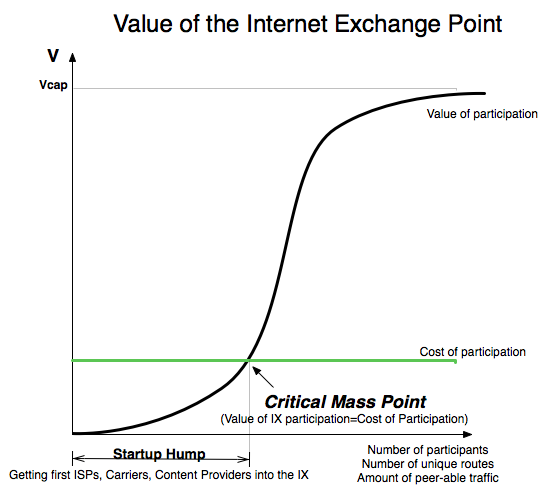Most IXes have a person who acts as a Chief Technical Liaison but without the title - you should get to know these people who know everyone. You may recognize the person after you read what the person actually does...

The Chief Technical Liaison is the externally facing position responsible for working with the broad Peering Community to maximize the value of the Internet Exchange Point. This is accomplished in a half dozen ways.

Definition: An Internet Region is a portion of the Internet, usually defined by geographical boundaries (country or continent borders), in which an Internet Peering ecosystem is contained.
Who are the Tier 1 ISPs (those who do not pay transit fees to reach any destination in the Internet Region)?
Where are the Tier 1 ISPs peering with each other? What IXes or colocation centers? How they peer (public, private, cross connects, and at what capacity)?
Who is trying to get peering with the Tier 1's and with what degree of success? Peering folks like to grouse about bad dealings with Tier 1's, so there is much to be learned over beers.
It is also instructive to hear what Tier 2 ISPs are adopting a selective peering policy.
What is the market price for transit at different levels of commit, and what is the price of transport to each IXes in the region. The strong Chief Technical Liaison has the numbers at the ready to discuss with peering folks how much it costs to build a backbone and peer in three locations in the U.S.
Who are the high growth Tier 2 ISPs and emerging network savvy content providers that are exploring entering the peering community?
Who was involved in the latest de-peering? What was the motivation for de-peering? The de-peered don't like to talk about it (since they were the rejected) and no one wants to be seen as the bad guy, so the de-peer'er doesn't talk either. It is difficult to learn about these things but the Chief Technical Liaison has the finger on the pulse of the community so knows this stuff..
The most important job of a Chief Technical Liaison is building the peering population at their IX. To this end the Chief Technical Liaison builds an extensive rolodex of peering contacts at each Tier 2 ISP, has a personal relationship with each one, knows who is moving where before it happens, and goes to every Internet operations forum.
Critical mass requires a peering population of folks who actively exchange traffic, so there is some sales and project management activity going on here. Every IX starts out with a small or zero population, and has to get folks to build in when there is no one there to peer with.

This is called the "startup hump", and is also known as the "Chicken and the Egg" problem. Some of the smartest IX operators in the world shared some of their tricks of the trade about this challenge with DrPeering in The Art of Peering - the IX Playbook.
The Chief Technical Liaison is the person the ISPs gravitate to when they want to know what is going on -- because this person knows everyone. This is also the person who can help new peering people ease into the peering community. For engineering folks who may not be socially inclined, asking for peering can be an intimidating process. The good news is that most of the peering folks are very friendly. However, some are a bit gruff, and a few are arrogant, unpleasant folks that look like Jabba the Hutt with a goatee. Start with the wrong people and the task can be intimidating. A good IX Chief Technical Liaison will assist with 5-6 introductions to the "cool Tier 2 peering folks" and the new peering person is off and running on their own.
An IX is in a difficult position - the value it provides to the population is the ability to peer with others. However, no one has to peer with anyone - it is purely voluntary. So, the value of the IX to the participants is completely out of the control of the IX operator.
Further, the IX can be valued based on the amount of traffic that is peered across it. Not only is this also out of the control of the IX... but the ISPs consider traffic information to be highly proprietary. So how does a Chief Technical Liaison determine who to go try to bring into the IX if the ISPs won't say how much of their traffic remains un-peered and to who that traffic goes to or comes from? It is like saying "Go do battle but I won't tell you where or who the enemy is."
The trick here is to generalize across the players by category and pull traffic information during informal conversations and in the sales process. "Tell me who you want to peer with and I will go bring them in" might come up at a sales call, followed by "and how much traffic would they allow you to offload?" Armed with this information, a Chief Technical Liaison can assume that other companies similar to this one have a similar traffic profile and similar traffic vectors.
The final side of this has to do with technical trajectory - where is the next load of traffic coming from. It helps to be curious, focused on the emerging technology trends, etc. This is how DrPeering stumbled upon the massive growth of potentially peer-able traffic from youTube before they became insanely popular and started looking into peering. This interaction set also led to The Video Internet : The Next Wave of Massive Disruption to the U.S. Peering Ecosystem white paper. Where is the next big wave of traffic coming from?
The population assembled at an IX may not be optimally peered; there may be folks who would peer if they knew the other folks already at the IX would be willing.
A good Chief Technical Liaison has a grid showing all the participants at the IX ; where the columns and rows intersect describe the peering relationship between the parties:
Managing this quilt of peering relationships is a challenge but helps optimize the value derived from participating in an IX. 
William B. Norton Peering Quilt Management Software
The other optimization that a Chief Technical Liaison does is to suggest upgrades to peering ports when the capacity reaches a certain point -- this is easy revenue for an IX.
A good Chief Technical Liaison does more than just private back room introductions ; they travel around the world, become recognized as an expert on the topic, and speak publicly whenever and wherever possible. This outreach does two things - it gets the IX name out there and provides a welcoming hand for new participants coming in from outside the ecosystem. Having something to speak about means writing and researching and documenting and sharing -- all activities that most easily fall out of the activities listed above.
So, those are the broad strokes of what a Chief Technical Liaison does. A good one is invaluable to an IX, invaluable to the ISP Peering Coordinators and their activities can be directly attributable to the IX bottom line.